Papers by Swaroop Ramaswamy

2020 Third International Conference on Smart Systems and Inventive Technology (ICSSIT)
Currently in the market, the most effective solar panels constitute the efficiency ratings as hig... more Currently in the market, the most effective solar panels constitute the efficiency ratings as high as 22.8%, while majority of the panel efficiencies vary from 15% to 17%. However, the theoretical photovoltaic conversion efficiency reaches 86.6% [1]. This is mainly due to the fact that, it is assumed that each photon is optimally used and have high concentration ratio which is not the case for terrestrial solar panels and hence have higher efficiencies. On the other hand, different factors disturb the power output of a terrestrial module in which most of the factors are related to the module itself. In the UAE region, one of the key issues that affect the performance of the photovoltaic module is dust. This remains as a challenging task and many research works are also carried out. In this paper, image processing is used to detect the dust and the percentage of dust is used as a parameter to put into the neural networks. Irradiance depending on the location is taken as one input and the percentage of dust sensor is used to predict the voltage in the panel. If the voltage of the panel is reduced to certain limit then the signal can be triggered to clean the solar panel.
2019 Amity International Conference on Artificial Intelligence (AICAI), 2019
This paper presents the forecasting of wind energy using neural networks based on the speed and t... more This paper presents the forecasting of wind energy using neural networks based on the speed and the rotational speed of the rotor. The wind power mainly depends on the velocity of the wind, density, and swept area of the wind mill which depends on the radius of the rotor. The power also depends on the efficiency of the motor, gear mechanisms. Hence the power varies according to the various parameters which makes the model non-linear. In this paper neural network is used to predict the output from the previous set of data. A new set of data is chosen and tested for the accuracy. It can be seen that the back propagation algorithm in neural network is able to classify the power output based on the speed of the rotor and the wind velocity.
2016 International Conference on Circuit, Power and Computing Technologies (ICCPCT), 2016
The Photovoltaic System is considered as one of the effective means of electrifying remote and is... more The Photovoltaic System is considered as one of the effective means of electrifying remote and isolated areas in today's world. This paper provides a complete optimal design to generate power using standalone PV system in the remote location of UAE. The pattern of the load is initially analyzed and the solar irradiance of the remote location near abudhabi is taken from the RET simulation software. Increasing the number of batteries and size of the array affects the life time, reliability and the initial cost. The complete design steps are carried out in designing charge controller, battery bank, inverter, string connections, azimuth angle and other parameters.
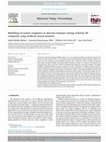
Materials Today: Proceedings, 2021
In abrasive waterjet machining (AWJM), water acts as an accelerating medium and abrasive particle... more In abrasive waterjet machining (AWJM), water acts as an accelerating medium and abrasive particles are used for cutting materials. This is a cost effective and environmentally friendly technique. Kevlar 49 is one of the most commonly used composite materials and is extensively used in aerospace industries where high strength-to-weight ratio and excellent corrosion resistance are required. This material can be processed by only by abrasive waterjet machining technology due to its high strength. The quality of AWJM is depending upon the process parameters of this technology. This paper provides an experimental investigation for the performance analysis of process parameters on machining Kevlar 49 using abrasive waterjet technology. In this paper mathematical model is also being developed to predict the surface roughness to find the relation between the inputs and the outputs. The first part predicts the surface roughness based on the pressure and the traverse speed whereas the second part indicates the surface roughness variation with standoff distance and the mass flow rate. The model is developed with the back-propagation algorithm using artificial neural network (ANN). The initial weights are assumed, and the algorithm predict and update the weights until it could predict the actual value. The final model is used to verify the results and is found that it is more than 95% accurate. Hence this model is used to study surface roughness by varying all the parameters theoretically.
419 Published By: Blue Eyes Intelligence Engineering & Sciences Publication Retrieval Number: ES2... more 419 Published By: Blue Eyes Intelligence Engineering & Sciences Publication Retrieval Number: ES2076017519/19©BEIESP Abstract: Abrasive waterjet cutting is one of the unconventional cutting processes capable of cutting extensive range of difficult-to-cut materials. This paper assesses the impact of process parameters on surface roughness which is a significant machining performance measure in abrasive waterjet cutting of hastelloy. The experimental parameters were selected based on Taguch’s design of experiments. Experiments were conducted in varying nozzle traverse speed, abrasive mass flow rate and standoff distance for cutting hastelloy using abrasive waterjet cutting process. The effects of these parameters on surface roughness have been discussed.

2017 International Conference on Infocom Technologies and Unmanned Systems (Trends and Future Directions) (ICTUS), 2017
Energy is an important aspect in the today's world. Due to the increase in the population and... more Energy is an important aspect in the today's world. Due to the increase in the population and the decrease in oil and other energy resources the power generation using renewable energy has become more popular. Due to the increase in power demand at the power station the forecasting becomes very essential to meet the demand on the daily basis. The amount of power generated depends on solar irradiance, temperature and weather forecast of future. Since there are uncertainties in the forecast it is essential to have very good forecasting techniques to predict the power at the grid stations. In this paper neural network has been used to predict the power generation from the metrological data. In this paper backpropagation algorithm is used for the prediction. The paper presents the forecasting the power and the feasibility analysis of PV system using a grid connected system. In this paper real data from a solar power plant in India is used for analysis. RET screen software has been used for the climatic conditions like humidity, temperature with the radiations. Neural networks model is designed to forecast the power that will be generated for the solar irradiation and the temperature.

2021 9th International Conference on Reliability, Infocom Technologies and Optimization (Trends and Future Directions) (ICRITO), 2021
The rising demand for energy in developing countries has led to the need for energy protection. W... more The rising demand for energy in developing countries has led to the need for energy protection. With the exhaustion of fossil fuels, their dreadful effect on the environment and their soaring prices, renewable forms of energy like solar and wind power have emerged rapidly, as clean and sustainable sources of generating electricity. It is crucial to make use of these renewable energy resources. Through innovation, technological advancements and modifications in design, performance of these renewable energy systems can be remarkably enhanced with reduction in costs of installation, operation and maintenance of these systems. Solar photovoltaic systems have emerged as the major renewable energy producers. Grid-connected photovoltaic solar systems are one of the best options for large-scale renewable energy generation. The evaluation of the efficiency of such a solar photovoltaic grid is one of the important aspects of evaluating real-time behaviour. Performance analysis may contribute to new grid-connecting solar photovoltaic (PV) systems' design, operation and maintenance. To assess the design of a plant, it is important to run simulations before starting the construction. This paper presents a simulation of 100 kW Si-poly photovoltaic plant connected to grid. 378 Si-poly PV modules of 265 Watt peak rating were used in the simulation process. The simulation is conducted on PVsyst which is a state-of-the-art software to design and simulate the performance of a PV system and generated relevant reports for the same. Performance of the photovoltaic system was analysed by the simulation results. It involves evaluating the PV array's energy efficiency, grid injection capacity, the performance ratio and other standard power generations per kWp. The inverters were also selected to match the rating of the solar array. The photovoltaic systems of 100 kWp generate 175.8MWh per annum. The annual rate of return is approximately 81.87%. The loss scheme is also measured throughout the year.
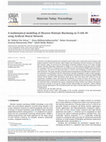
Materials Today: Proceedings, 2020
Ti-6Al-4V is classified among the most commonly used Ti-alloys and is extensively used in aerospa... more Ti-6Al-4V is classified among the most commonly used Ti-alloys and is extensively used in aerospace and medical industries where low-density, high strength and outstanding corrosion resistance are required. This material cannot be processed by conventional machining methods because of its high strength. Abrasive Waterjet Machining, abbreviated as AWJM, is an unconventional machining process suitable for machining Ti-6Al-4V as it generates less heat affected zone. The quality of AWJM is governed by process parameters, the selection of these parameters is critical in this technology to achieve the desirable output measures. This paper provides an experimental investigation for the performance analysis of process parameters on machining Ti-6Al-4V using abrasive waterjet technology. In order to select appropriate parameters, a mathematical equations were developed using Regression Investigation Method (RIM) Artificial Neural Network (ANN) procedures. Based on the input and output data collected from the experiments, modelling is done and tested for the different set of data to ensure the accuracy. These mathematical models can be used to identify the static and dynamic behavior of the process. These models will further help in simulating the process, expanding the design facilities and studying the physical and chemical variation in the process. Models provide understanding the operations, control methods and the possible optimization. The developed models also help in documenting the performance of the existing system.
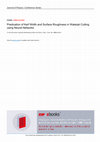
Journal of Physics: Conference Series, 2019
Abrasive waterjet cutting is one of the unconventional methods used to cut some of the difficult ... more Abrasive waterjet cutting is one of the unconventional methods used to cut some of the difficult to cut materials. In certain materials this method has proved to give better results compared to the conventional methods. In this model the water jet cutting is done on hastelloy using the three parameters which are abrasive mass flow rate, traverse speed, and the stand-off distance. The mathematical modelling to predict the kerf width based on these three input parameters is discussed in this paper. As the relation between the input and the output parameter is non-linear in nature neural network back propagation algorithm is used for the prediction. Here the experiment is conducted using waterjet cutting machine and the data’s like surface roughness, metal removal rate, kerf width and the kerf angle data are collected. Both the input and the output parameters are fed to the neural network toolbox programmed in the MATLAB. After 1000 iterations it has been found that the prediction is c...
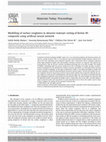
Elsevier Materials Today, 2020
In abrasive waterjet machining (AWJM), water acts as an accelerating medium and abrasive particle... more In abrasive waterjet machining (AWJM), water acts as an accelerating medium and abrasive particles are used for cutting materials. This is a cost effective and environmentally friendly technique. Kevlar 49 is one of the most commonly used composite materials and is extensively used in aerospace industries where high strength-to-weight ratio and excellent corrosion resistance are required. This material can be processed by only by abrasive waterjet machining technology due to its high strength. The quality of AWJM is depending upon the process parameters of this technology. This paper provides an experimental investigation for the performance analysis of process parameters on machining Kevlar 49 using abrasive waterjet technology. In this paper mathematical model is also being developed to predict the surface roughness to find the relation between the inputs and the outputs. The first part predicts the surface roughness based on the pressure and the traverse speed whereas the second part indicates the surface roughness variation with standoff distance and the mass flow rate. The model is developed with the back-propagation algorithm using artificial neural network (ANN). The initial weights are assumed, and the algorithm predict and update the weights until it could predict the actual value. The final model is used to verify the results and is found that it is more than 95% accurate. Hence this model is used to study surface roughness by varying all the parameters theoretically.
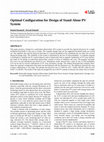
This paper presents a design for a stand-alone photovoltaic (PV) system to provide the required e... more This paper presents a design for a stand-alone photovoltaic (PV) system to provide the required electricity for a single residential household in rural area in Jordan. The complete design steps for the suggested household loads are carried out. Site radiation data and the electrical load data of a typical household in the considered site are taken into account during the design steps. The reliability of the system is quantified by the loss of load probability. A computer program is developed to simulate the PV system behavior and to numerically find an optimal combination of PV array and battery bank for the design of stand-alone photovoltaic systems in terms of reliability and costs. The program calculates life cycle cost and annualized unit electrical cost. Simulations results showed that a value of loss of load probability LLP can be met by several combinations of PV array and battery storage. The method developed here uniquely determines the optimum configuration that meets the load demand with the minimum cost. The difference between the costs of these combinations is very large. The optimal unit electrical cost of 1 kWh for LLP = 0.049 is $0.293; while for LLP 0.0027 it is $0.402. The results of the study encouraged the use of the PV systems to electrify the remote sites in Jordan.










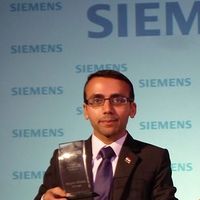
Uploads
Papers by Swaroop Ramaswamy